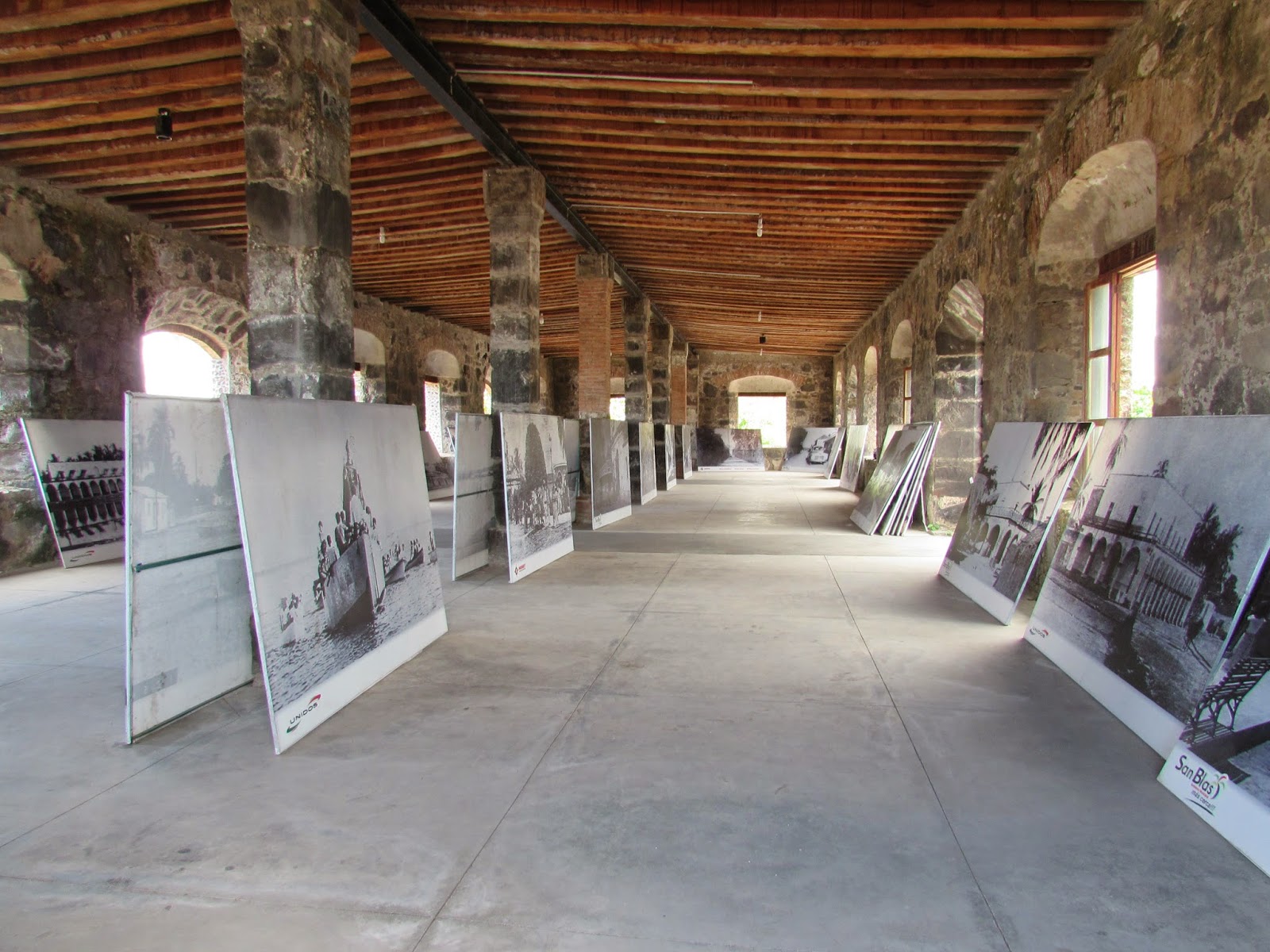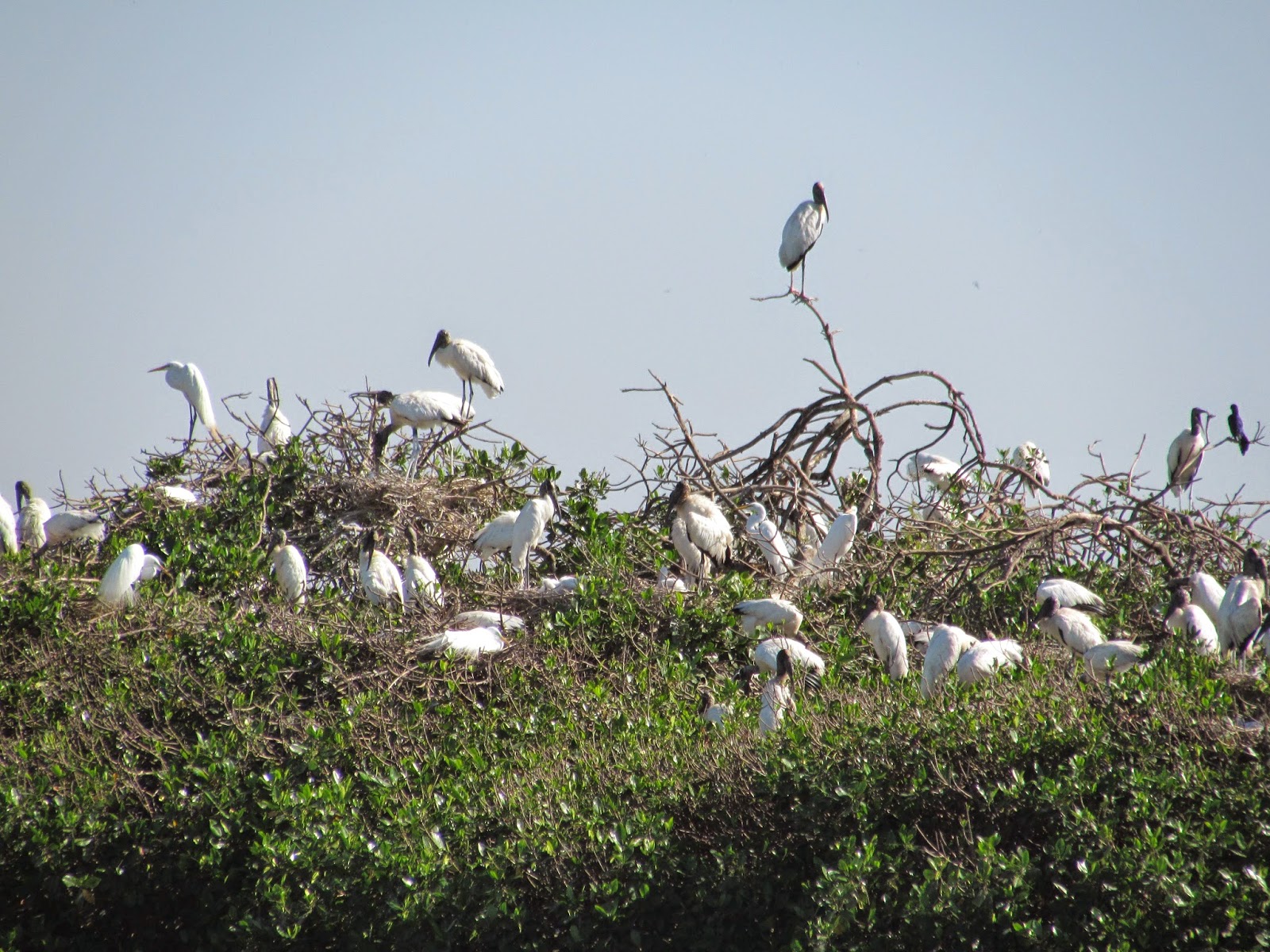We arrived in San Blas on Easter Monday and headed for the Marina Fonatur in the Pozo River Estuary. This government run cookie cut marina was built exactly the same as the other three that we’ve stayed in but we don’t like it nearly as much as Mazatlan’s, especially because the little roof top pool is in disrepair. Having a pool in this heat would be a blessing. Temperatures range from high 80’s (28 C) during the day to mid 70’s (23 C) at night. Humidity hovers around 90% and we feel like we need to shower a couple of times a day.
 |
| A map of San Blas we found at the museum. The town is 128 miles south of Mazatlan |
 |
| Sunset west of the marina |
The population of San Blas is around 10,000, spread out between two main estuaries and Rio Tovara, which winds to the south. Almost all of town is housed in one storey single family cinderblock homes. There are dozens of tiny Mexican restaurants, many with fresh grilled fish, lobsters and prawns.
 |
| Acres of palms and San Blas from the hilltop fort at La Contaduria |
 |
| Five grilled fish restaurants in one block! |
This region is well known for its hundreds of species of birds and its crocodile population. Tour companies offer river excursions on two of the rivers. Friends from Enchante took a river jungle excursion up Estero de San Cristobal and highly recommended guide Chenco to us. With their directions we were able to find Chenco’s tiny house where three generations lived together. We easily set up a Tuesday morning excursion and were very happy with our decision.
Covered with bug spray we set off in Chenco’s open panga and headed up the San Cristobal Estuary as the sun was rising.
Chenco pointed out dozens of birds to us, naming each of them in both English and Spanish. I wish I had written them down because I can’t remember many of them now. However, those of you who love birds will be able to identify them if you want to. Our trip took over four hours and we covered about 10 miles of the 33 mile long river. At dawn it felt like we were almost in fog as vapour evaporated off the river.
Floating islands of water hibiscus and lilies swirled in the current while we craned our necks to catch the incredibly diverse bird population perched in the tops of the thick jungle trees and brush.
We passed a few small shallow draft fishing canoes pulled up along the bank and waved to a fisherman throwing his net in one of the lagoons.
 |
| The estuary opened up to this beautiful lagoon |
 |
| Spring is in the air as wood storks perch on their nest |
 |
| Welcome to the world! |
Chenco’s keen eyesight spotted well camouflaged crocodiles sunning themselves. He slowed his panga down each time then cut the engine so we could watch the huge reptiles in their natural habitat. The longest crocodile we saw was 11 feet!
 |
| Smile for the camera! |
 |
| In one swift action he's plunging into the water. |
 |
| The word 'lurking' comes to mind...He was big and watching us! |
Jim wants to add his thoughts about other aspects of San Blas, which I know you’ll enjoy....
San Blas is a cool town with a really strong feeling of history. It has a great connection with Victoria and southern B.C. Ships sailed to B.C. by Valdez, Galiano and Quadra were built here in the sixteenth through eighteenth centuries. We went to visit the remains of a fort built by the Spanish and English in the 1700's when they were allied against the French. Later, the French and Spanish were allies and used the fort to defend the town from the British navy. Made me think to myself "Now now kids, if you can't play nice together, I'll have to take your silver away". We met a local history teacher and four of his students at the fort who were happy and proud to tell us all about the history of the area.
 |
| La Contaduria, the old fort and accounting house on the hilltop overlooking San Blas. |
 |
| Check out the thatched roof built around the palm tree |
 |
 |
| A new roof protects the historical site |
 |
| Close up's of the San Blas mural size photos in the old fort |
 |
| Jim wielding an antique Chinese sword recovered from a wreck off the coast of San Blas |
 |
| Isaac and his students pose in front of portraits of| Galiano (right) and Bodega Y Quadra (next to Galiano) |
 |
| We were impressed with how busy the two year old volunteer-run museum was with Isaac showing us replicas of two century old charts and photos |
We stumbled across this beautiful historical church while walking back from the fort on the east side of the hill. It was built in 1769 and used until 1872 when the bells were removed. Our guidebook says that Henry Wadsworth Longfellow wrote the poem "The Bells of San Blas" to honour this once famous church.
 |
| Templo de la Virgen del Rosario church 1769 - 1872 |
We also met a cool couple, Eva and Salvadore, who run a tiny tienda, or convenience store, here. The store has literally about 60 square feet and they have been running it together for the last 51 years.
 |
| Our new amigos, Salvador and Eva. Salvadore dug out their old globe so we could show him where Victoria was. He's been to the US 22 times to visit his many kids! |
We spent most afternoons having a siesta because of the heat. I usually lounged in the cockpit while Jim hung out below deck with the fans going, playing solitaire or reading. The other day we were both lounging around mid-afternoon when we heard the most awful noises coming from our boat near the waterline. I thought we had a loose line on deck that was flapping in the afternoon breeze that came up. Jim thought it might be wood inside the boat flexing in the intense heat. The sound had a definite 'whack' to it over and over but with no distinct rhythm. At one point Jim was laid prone on the sole (floor) with his ear pressed tightly to it trying to locate exactly where the whacking/cracking sound was originating. After a couple of tense hours of speculation we were still scratching our heads. We wandered over to another cruising boat next to us and asked them if they had any suggestions and Ed did. Sure enough, it turned out the whacking was the product of parrot fish attacking our hull while eating weeds and algae. Apparently they really throw themselves into their meals! We were happy to realize there was nothing wrong with out boat!
We’ll be leaving San Blas on Monday morning at high tide and heading a bit further south to Chacala then on to Bahia de Banderas where Puerto Vallarta is located. Until then…






















































